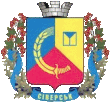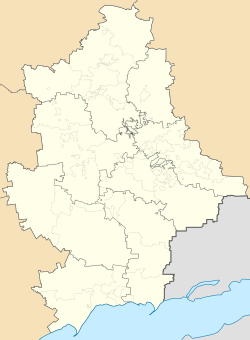Siversk
Siversk
Сіверськ | |
|---|---|
 Railway station in Siversk | |
| Coordinates: 48°51′47″N 38°5′50″E / 48.86306°N 38.09722°E | |
| Country | |
| Oblast | Donetsk Oblast |
| Raion | Bakhmut Raion |
| Hromada | Siversk urban hromada |
| Foundation | 1913 |
| City rights | 1961 |
| Area | |
| • Total | 11 km2 (4 sq mi) |
| Elevation | 72 m (236 ft) |
| Population (2022) | |
| • Total | 10,875 |
| • Density | 990/km2 (2,600/sq mi) |
| Postal code | 84522-84524 |
| Area code | +380 6274 |
Siversk (Ukrainian: Сі́верськ, IPA: [ˈs⁽ʲ⁾i.wersʲk]; Russian: Се́верск, romanized: Seversk), formerly known as Yama (Я́ма) until 1973, is a small city in Bakhmut Raion, Donetsk Oblast, Ukraine. Its economy has traditionally been based around the mining and processing of dolomite. In January 2022, it had an estimated population of 10,875.[1]
During the
It is the administrative center of Siversk urban hromada, one of the hromadas of Ukraine.
Geography
Siversk is located in the historical, cultural, and economic Donbas region of eastern Ukraine.[3] It is located 36 kilometres (22 mi) northeast of Bakhmut.[4]
Siversk lies at the bottom of a lowland, in a river valley, surrounded on all sides by smaller settlements.[5][6]
History
Preceding settlements
Archeologists have discovered human settlements on the territory of modern Siversk dating back to the Stone Age. At different times throughout history, the area has been inhabited by Sarmatians, Goths, Huns, Avars, Alans, Bulgarians, Slavs, Khazars and Cumans. The land was conquered by the Mongol Empire during the Mongol invasion of Kievan Rus' in the mid-13th century.[5]
In the 16th century, the land on the banks of the
On the bank of the Kamianka river, a tributary of the Bakhmutka, a village named Kamianske was founded, named after the river. In 1881, an agricultural school was opened in Kamianske. Volodymyr Sosiura would study at this school.[5] In 1910, the Yama railway station was built.[4]
Founding and 20th century history

In 1913, a dolomite plant was built near the station, to process dolomite from the nearby mine.[4][5] This year is generally considered to be the "official" year of the founding of Siversk. The same year, a worker's settlement named Yama was founded, on the bank of the Yama river. Workers of the mine and the railway station lived in the settlement. The toponym Yama literally means "pit", in reference to the deep river valley.[5]
The settlements were occupied by the
The area saw fighting again during World War II.[4] On 27 January 1950, most of the disparate minor settlements - including Rodionivka and Chornohorivka - were merged into Yama. The worker's settlement near the dolomite mine was excluded from this, instead becoming the settlement Dolomitne.[7] Yama was part of Yama Raion until 10 September 1959, when the raion was abolished, and its territory, including Yama, was merged into Artemivsk Raion.[8]
Yama received city status in 1961, and was renamed to Siversk on 2 August 1973.[5] The name "Siversk" is derived from the Siversky Donets river.[6] In 1980, a museum was opened about Volodymyr Sosiura, the poet who had visited the area.[6]
In the wake of the
Russo-Ukrainian War
In April 2014, during the beginnings of the
Despite the end of actual fighting in the city itself, the trend of economic and population decline accelerated,[5] and the city remained a "war zone" for the remainder of the war in Donbas, though most of the residents of the city did not flee at the time.[11] As of 2016, Siversk was located about 50 kilometres (31 mi) from the frontline.[6]
During the full-scale
On 28 June 2023, Siversk officially launched a sister city program with Weston, Connecticut.[15] Siversk has not recovered from the war damage, with only about 1,000 residents remaining in the city as of July 2023.[2]
Economy

The main economy of Siversk has traditionally been dolomite mining and processing since 1913, until 2008 when the mines were exhausted. The mineral was used in metallurgy, construction, and the chemical industry, and it was the main source of income to the city.[5]
Siversk also contains the "Yamskyi" state farm, a milk factory, and a sewing factory.[4][6]
Education
As of 1970, Siversk had two secondary schools, a primary school, a boarding school, a music school, and an agricultural school. There were eight kindergartens and nurseries, and four libraries.[4] However, by 2016, there were only three schools left.[6]
Infrastructure
Public transport in the city is minimal. There is one bus that travels in a loop around the city, and "if it breaks down, passengers walk". Ukrainian media have said that the Ukrainian joke about roads in eastern Ukraine having been "bombed even before the war" applies to Siversk.[6]
Demographics
|
|
As of the
Gallery
-
Bakhmutka river near Siversk
-
A typical vegetable garden along the Bakhmutka River in Siversk
-
Monument to labor glory - "Universal" tractor in Siversk
-
Panorama of a wheat field near Siversk
-
Photo of a chalk mountain near the city of Siversk
References
- ^ a b Чисельність наявного населення України на 1 січня 2022 [Number of Present Population of Ukraine, as of January 1, 2022] (PDF) (in Ukrainian and English). Kyiv: State Statistics Service of Ukraine. Archived (PDF) from the original on 4 July 2022.
- ^ a b c d e Sirgany, Sarah; Gak, Kostyantin; Wedeman, Ben (10 July 2023). "'We are waiting for that minute when the war ends.' Residents of a Ukrainian frontline town cling on to life". Retrieved 27 November 2023.
- ISSN 0362-4331. Retrieved 27 November 2023.
- ^ a b c d e f g "Яма, Артемівський район, Донецька область". Історія міст і сіл Української РСР (in Ukrainian).
- ^ a b c d e f g h i j k l m n o p "Місто, що не по зубах окупантам: історія Сіверська" (in Ukrainian). 28 August 2022. Retrieved 27 November 2023.
- ^ a b c d e f g h i j k Свобода, Радіо (13 June 2016). "Сіверськ. Станція Яма". Радіо Свобода (in Ukrainian). Retrieved 27 November 2023.
- ^ (in Ukrainian) – via Wikisource.
- ^ (in Ukrainian) – via Wikisource.
- ^ "War in Ukraine: 'Those who can't dig, they die'". Le Monde.fr. 9 July 2022. Retrieved 27 November 2023.
In April 2014, at the beginning of the war, when the Moscow-backed Ukrainian separatists had seized Siversk, Ivan had fled to Kharkiv before returning, four months later, in July, after the liberation of the city by the Ukrainian army.
- ^ "Ukraine forces clash with separatists at Donetsk airport". BBC News. 10 July 2014.
- ^ "Battleground Towns: In the Heart of Russia's War in Ukraine". 12 April 2023. Retrieved 27 November 2023.
- ^ Ellyatt, Holly; Macias, Amanda. "Russians 'destroying everything they see' in the Donbas; many dead and wounded after missiles hit Ukrainian city". Retrieved 27 November 2023.
- ^ "RUSSIAN OFFENSIVE CAMPAIGN ASSESSMENT, JULY 20". Retrieved 27 November 2023.
- ^ Tara Subramaniam; Sana Noor Haq; Aditi Sangal; Mike Hayes; Maureen Chowdhury; Elise Hammond (12 September 2022). "September 12, 2022 Russia-Ukraine news". Retrieved 27 November 2023.
- ^ "Ukraine Sister City - Siversk". Town of Weston, Connecticut. Retrieved 27 November 2023.
- ^ a b c d e f "Cities & towns of Ukraine". pop-stat.mashke.org. Retrieved 27 November 2023.
- ^ https://socialdata.org.ua/projects/mova-2001/
- ^ https://datatowel.in.ua/pop-composition/ethnic-cities









